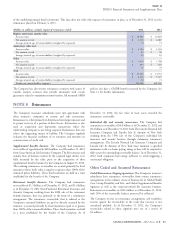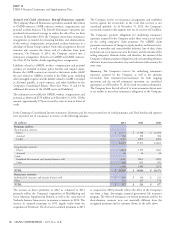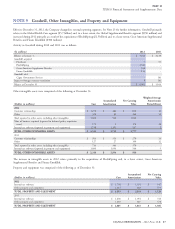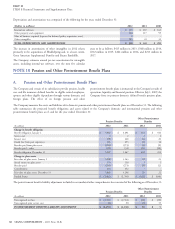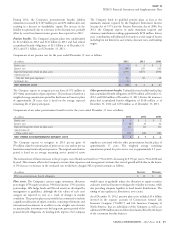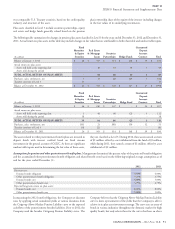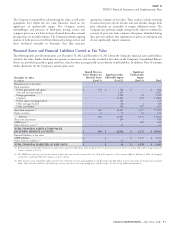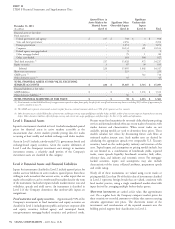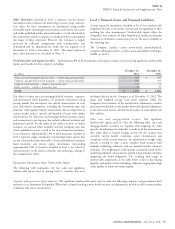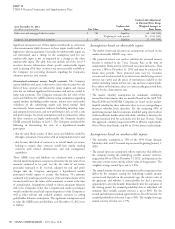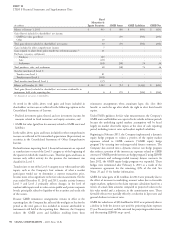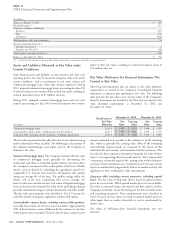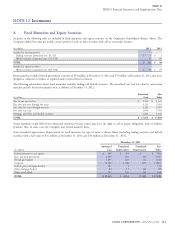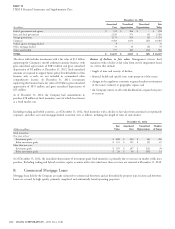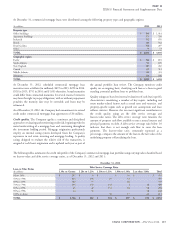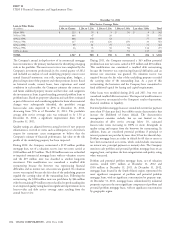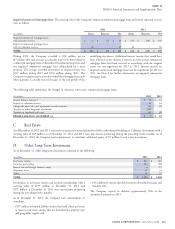Cigna 2012 Annual Report Download - page 117
Download and view the complete annual report
Please find page 117 of the 2012 Cigna annual report below. You can navigate through the pages in the report by either clicking on the pages listed below, or by using the keyword search tool below to find specific information within the annual report.
PART II
ITEM 8 Financial Statements and Supplementary Data
Other derivatives classified in Level 2 represent over-the-counter
Level 3 Financial Assets and Financial Liabilities
instruments such as interest rate and foreign currency swap contracts. Certain inputs for instruments classified in Level 3 are unobservable
Fair values for these instruments are determined using market (supported by little or no market activity) and are significant to their
observable inputs including forward currency and interest rate curves resulting fair value measurement. Unobservable inputs reflect the
and widely published market observable indices. Credit risk related to Company’s best estimate of what hypothetical market participants
the counterparty and the Company is considered when estimating the would use to determine a transaction price for the asset or liability at
fair values of these derivatives. However, the Company is largely the reporting date.
protected by collateral arrangements with counterparties, and
determined that no adjustment for credit risk was required as of The Company classifies certain newly-issued, privately-placed,
December 31, 2012 or December 31, 2011. The nature and use of complex or illiquid securities, as well as assets and liabilities relating to
these other derivatives are described in Note 13. GMIB, in Level 3.
Fixed maturities and equity securities. Approximately 8% of fixed maturities and equity securities are priced using significant unobservable
inputs and classified in this category, including:
December 31, December 31,
(In millions)
2012 2011
Other asset and mortgage-backed securities – valued using pricing models $ 598 $ 565
Corporate and government fixed maturities – valued using pricing models 596 335
Corporate fixed maturities – valued at transaction price 123 72
Equity securities – valued at transaction price 34 30
TOTAL $ 1,351 $ 1,002
Fair values of other asset and mortgage-backed securities, corporate developed directly by the Company as of December 31, 2012. The
and government fixed maturities are primarily determined using range and weighted average basis point amounts reflect the
pricing models that incorporate the specific characteristics of each Company’s best estimates of the unobservable adjustments a market
asset and related assumptions including the investment type and participant would make to the market observable spreads (adjustment
structure, credit quality, industry and maturity date in comparison to to discount rates) used to calculate the fair values in a discounted cash
current market indices, spreads and liquidity of assets with similar flow analysis.
characteristics. For other asset and mortgage-backed securities, inputs Other asset and mortgage-backed securities. The significant
and assumptions to pricing may also include collateral attributes and unobservable inputs used to value the following other asset and
prepayment speeds. Recent trades in the subject security or similar mortgage-backed securities are liquidity and weighting of credit
securities are assessed when available, and the Company may also spreads. An adjustment for liquidity is made as of the measurement
review published research, as well as the issuer’s financial statements, date when there is limited trading activity for the security that
in its evaluation. Approximately 10% of fixed maturities classified in considers current market conditions, issuer circumstances and
level 3 represent single, unadjusted, non-binding broker quotes that complexity of the security structure. An adjustment to weight credit
are not considered market observable. Certain subordinated corporate spreads is needed to value a more complex bond structure with
fixed maturities and private equity investments, representing multiple underlying collateral with no standard market valuation
approximately 10% of securities included in level 3, are valued at technique. The weighting of credit spreads is primarily based on the
transaction price in the absence of market data indicating a change in underlying collateral’s characteristics and their proportional cash flows
the estimated fair values. supporting the bond obligations. The resulting wide range of
unobservable adjustments in the table below is due to the varying
Quantitative Information about Unobservable Inputs liquidity and quality of the underlying collateral, ranging from high
credit quality to below investment grade.
The following table summarizes the fair value and significant
unobservable inputs used in pricing Level 3 securities that were
Corporate and government fixed maturities. The significant unobservable input used to value the following corporate and government fixed
maturities is an adjustment for liquidity. When there is limited trading activity for the security, an adjustment is needed to reflect current market
conditions and issuer circumstances.
CIGNA CORPORATION - 2012 Form 10-K 95


